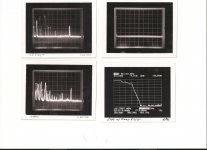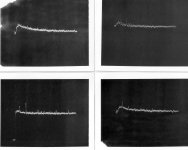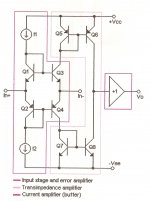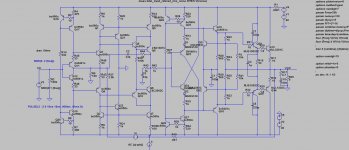More and more equipmnt have smps inside. TV's, computers, of course, and it produces a LOT of emi/rfi on the ac power line.
Filtering and equipment to equipment isolation is required if you do not want to spread and distribute that all over the ac lines where other equipment is also plugged in to it.
Thx-RNMarsh

Ignor these pictures.. I dont know how to remove them.
Filtering and equipment to equipment isolation is required if you do not want to spread and distribute that all over the ac lines where other equipment is also plugged in to it.
Thx-RNMarsh

Ignor these pictures.. I dont know how to remove them.
Attachments
Last edited:
You mean switching frequency residues and their harùonics ? Well, good SMPS (poor exists like the one witch was in my Brehinger 2496 ;-[ ) can have a very good noise factor, on my point of view. Care has to be taken for good cabling, filtering AC lines side as well as output side and shielding, of course.Christophe,
I may be wrong on this point but I think what Richard is saying about the EMI/RFI of a smps is not its own inherent immunity to those things passing through them.
Last edited:
What I showed is measured (freq spectrum) on the ac power lines when a piece of equipment, using smps, is turned on. When several such equipment are on the same ac line, the noise/rfi etc is very high.
Thx-RNMarsh
Thx-RNMarsh
Christophe,
Yes my concern is that with many smps units they will produce their own radiation that we have to watch out for being picked up by a cable or even a board trace and injected into the circuit. Like you observed with the Berhinger you just mentioned. This was always such a common problem with audio cards inside of PC computers in the past I just shy away from those power supplies for audio use because of this.
Yes my concern is that with many smps units they will produce their own radiation that we have to watch out for being picked up by a cable or even a board trace and injected into the circuit. Like you observed with the Berhinger you just mentioned. This was always such a common problem with audio cards inside of PC computers in the past I just shy away from those power supplies for audio use because of this.
Hi Guys
SMPS is about the worst power source to use for linear circuitry. Output impedance is variable and NOT low as is often advertised.
If one must use SMPS, add an active hum filter between it and the linear load. The hum filter provides a constant low-z output more in line with what is required by the linear circuitry. After all, the PSU is the other half of the signal path.
I believe Richard's comments in post 361 was simply that in a typical split-rail supply and amplifier, the unequal instantaneous variation of the rails can allow ingress of supply-borne noise to the circuit. Usually, good rail filtering and adequate PSRR measures assure that such ingress is not a problem in most amplifier.
Have fun
Kevin O'Connor
SMPS is about the worst power source to use for linear circuitry. Output impedance is variable and NOT low as is often advertised.
If one must use SMPS, add an active hum filter between it and the linear load. The hum filter provides a constant low-z output more in line with what is required by the linear circuitry. After all, the PSU is the other half of the signal path.
I believe Richard's comments in post 361 was simply that in a typical split-rail supply and amplifier, the unequal instantaneous variation of the rails can allow ingress of supply-borne noise to the circuit. Usually, good rail filtering and adequate PSRR measures assure that such ingress is not a problem in most amplifier.
Have fun
Kevin O'Connor
The amp circuits PSR and CMR requirments are reduced when the PS does not have a differential variation between +/- under dynamic conditions.
The amp's distortion will be lower when both PS polarities' level remain the same level... even if that level changes somewhat. The level can go up and down as long as they are kept the same.
The SMPS noise is a seperate issue from this.
Thx-RNMarsh
The amp's distortion will be lower when both PS polarities' level remain the same level... even if that level changes somewhat. The level can go up and down as long as they are kept the same.
The SMPS noise is a seperate issue from this.
Thx-RNMarsh
Last edited:
Struth, that is the common believe, an urban legend, on my point of view. This is what i thought before had made measurements on several amplifier rails. And i always prefer SMPS on a subjective listening point of view, comparing the two. Severall blind tests on the web confirm this.SMPS is about the worst power source to use for linear circuitry.
Please look at the comments and measurements of Andrej, in the VSSA thread, as an other example.Of course, this suppose a good SMPS, with enough power margin: Many of them are not referenced for continuous power.
Last edited:
Struth, that is the common believe, an urban legend, on my point of view. This is what i thought before had made measurements on several amplifier rails. And i always prefer SMPS on a subjective listening point of view, comparing the two. Severall blind tests on the web confirm this.
Please look at the comments and measurements of Andrej, in the VSSA thread, as an other example.Of course, this suppose a good SMPS, with enough power margin: Many of them are not referenced for continuous power.
Hi Christophe,
I have read those comments and it seems like there could be merit in SMPS. Especially if they have enough current and are fast enough to keep the rails up and minimise the delta between polarities under load.
The noise they can put on the ac line and what the other connected equipment recieves is still an issue to avoid/minimise.
Thx-RNMarsh
Hi Guys
My SMPS comments are from direct and indirect experience.
For example: A friend was building some headphone amps using THAT chips and some others, to do an A-B comparison. He powered these from a pair of SMPSs that were rated for many times the VA load that even all of the circuits might pull combined. As soon as he applied signal and any of the circuits had to drive a load, the SMPs would shut down.
We added the active interface everything was happy.
In the headphone forums, somebody measured the supply rail noise - or was it output node noise? - of the Stax mini driver. This runs off +/- rails and uses a SMPS supply. With the stock supply, there was tonnes of debris on the supply rails and the outputs. Using a linear supply everything was flat DC and quiet as it should be. Using an external SMPS was between these results.
In the class-D amp world, synchronous supplies are preferred to match the loading with the supply capability. Class-D is still heavily compromised and an immature technology, so not good for much. Listening tests to each his own.
Esperado, we must agree to disagree about SMPS supporting linear circuits. Call me old school, but linear supplies always sound and perform better from what I have seen. If SMPS is so superior, you would see all the best amps using them, yet none do (that I consider worth looking at).
Common beliefs are sometimes correct; sometimes they change, as I pointed out above; this one I will likely believe forever.
Yes, SMPS is often beneficial due to its low EMI radiation and otherwise easy to block EMI. However, most off-the-shelf units have a 1-yr or shorter warranty. "Long life" may be 2-yrs. Linear supplies are comparatively bullet-proof, and quite importantly for this forum, they are within the skills of most people to design and construct. All you have to do is size the PT correctly.
Have fun
Kevin O'Connor
My SMPS comments are from direct and indirect experience.
For example: A friend was building some headphone amps using THAT chips and some others, to do an A-B comparison. He powered these from a pair of SMPSs that were rated for many times the VA load that even all of the circuits might pull combined. As soon as he applied signal and any of the circuits had to drive a load, the SMPs would shut down.
We added the active interface everything was happy.
In the headphone forums, somebody measured the supply rail noise - or was it output node noise? - of the Stax mini driver. This runs off +/- rails and uses a SMPS supply. With the stock supply, there was tonnes of debris on the supply rails and the outputs. Using a linear supply everything was flat DC and quiet as it should be. Using an external SMPS was between these results.
In the class-D amp world, synchronous supplies are preferred to match the loading with the supply capability. Class-D is still heavily compromised and an immature technology, so not good for much. Listening tests to each his own.
Esperado, we must agree to disagree about SMPS supporting linear circuits. Call me old school, but linear supplies always sound and perform better from what I have seen. If SMPS is so superior, you would see all the best amps using them, yet none do (that I consider worth looking at).
Common beliefs are sometimes correct; sometimes they change, as I pointed out above; this one I will likely believe forever.
Yes, SMPS is often beneficial due to its low EMI radiation and otherwise easy to block EMI. However, most off-the-shelf units have a 1-yr or shorter warranty. "Long life" may be 2-yrs. Linear supplies are comparatively bullet-proof, and quite importantly for this forum, they are within the skills of most people to design and construct. All you have to do is size the PT correctly.
Have fun
Kevin O'Connor
Let-me tell-you a story, the one of my personal amplifier (a VERY fast CFA 2X140 Watts).Esperado, we must agree to disagree about SMPS supporting linear circuits. Call me old scho
Its power supply was made from RMI/RFI AC plug filter, a 1000VA toroid, with soft recovery rectifier, damped, followed by a stabilized cap multiplier (see attached).

One friend reported-me its surprise to had found a SMPS to sound better on a restauration he made of a Quad 405, and the same result on a class D amplifier.
As i'm always curious, and despite my distrust (the same than your), i had made the test with a regulated Connex... It was better, obviously, both on listening and noise measurements at normal listening levels with real speakers.
GO figure, i had to fight against my laziness to modify my amp.
Made the same with my preamplifier, same conclusion. I made the same with class D amps (not so immature, tell this to all the Bruno's customers) ;-). Same conclusion.
Andrej (L.C.) made the same for its VSSA (may-be on my insistence ?), with a non regulated Hypex SMPS, same conclusion. How can-we all be wrong ?
Of course, you will always able to demonstrate the contrary, with poor SMPS, like this awfull one i had in my DCX2496, replaced by a linear. 🙂
This said, if i had to design an expensive so called "high end" commercial amplifier today, i would use a linear for a simple reason easy to describe: Your distrust. The goal is more to sell than to produce the best....but never tell...
About long life, i have no experience, and, if electrolytic reduce their life with the number of charges/discharges, yes, you are probably right. Anyway, they are too short living (<10years) even in linear PSUs
Last edited:
smps can be made quite both in and out, as well as having enough bw (3-10K I believe is fairly routine nowadays) to support the lower frequency audio variations. This has been shown for years in the aerospace where power dissipation is a concern in conjunction with low noise detector systems.
One drawback is they can also be made very noisy and create contaminating fast common and differential mode currents.
Would seem ideal built into an integrated system with appropriate filtering / control with potential options such clock synchronization, or other lower noise techniques.
Thanks
-Antonio
One drawback is they can also be made very noisy and create contaminating fast common and differential mode currents.
Would seem ideal built into an integrated system with appropriate filtering / control with potential options such clock synchronization, or other lower noise techniques.
Thanks
-Antonio
I think the action of the feedback loop will make it high, by bootstrapping the input with the output
About long life, i have no experience, and, if electrolytic reduce their life with the number of charges/discharges, yes, you are probably right. Anyway, they are too short living (<10years) even in linear PSUs
Capacity remains unchanged with time, the important parameter is tan-delta. Some data on electrolytics (in french)
Des condensateurs chimiques
The unreliability of electrolytics rely more on legend than on tests.
To summarize collected experiences, they are much more reliable than one may think, they rarely loose their initial characteristics before fifteen years. Replacing before twenty years is generally absolutely unuseful.
There have been some very bad experiences with some asian products but these products dit not have a lifetime longer than three years.
Hi Richard !
I like that schematic ! ,
I see there one Very Stable circuit !
I think that for simple power Amp application Current Conveyers ( +1 ) part can be very easy formed from two standard power N/P lateral Fet`s pair , directly driven from Q6/Q8 .
Best Regards !
I like that schematic ! ,
I see there one Very Stable circuit !
I think that for simple power Amp application Current Conveyers ( +1 ) part can be very easy formed from two standard power N/P lateral Fet`s pair , directly driven from Q6/Q8 .
Best Regards !
Nobody showed CFA schematic here yet. Here is one (to complicate) but with THD20k 0.001369% at 50W/8ohm, PHM is 75 degree anf GM is 13dB.
BR Damir
Baxendall super pairs as input devices? Nice 😉
Hi Guys
The circuit in post-375 is at the heart of many power amps Yorkville Sound designed for PA use, beginning with their AP500 mosfet output amp, and continuing in various forms to their current model range.
Dadod's circuit in post-380 is nice, embodying nested feedback and HEC.
Have fun
Kevin O'Connor
The circuit in post-375 is at the heart of many power amps Yorkville Sound designed for PA use, beginning with their AP500 mosfet output amp, and continuing in various forms to their current model range.
Dadod's circuit in post-380 is nice, embodying nested feedback and HEC.
Have fun
Kevin O'Connor
Damir,
As noted in one of your threads, nice work.
It would be beneficial to show the high loop gain, and since it's always a topic the slew rate with and without the 2nd order compensation.
With a cfa what is the motivation to encompass the input stage within a nested loop, or is there a significant advantage given its linearity to start with?
Don't mean to pile on work for you but could lead to interesting discussion.
Thanks
-Antonio
As noted in one of your threads, nice work.
It would be beneficial to show the high loop gain, and since it's always a topic the slew rate with and without the 2nd order compensation.
With a cfa what is the motivation to encompass the input stage within a nested loop, or is there a significant advantage given its linearity to start with?
Don't mean to pile on work for you but could lead to interesting discussion.
Thanks
-Antonio
- Home
- Amplifiers
- Solid State
- CFA Topology Audio Amplifiers


